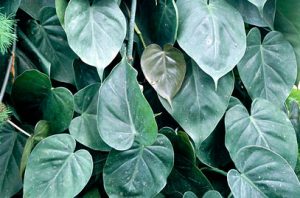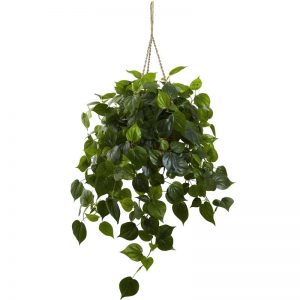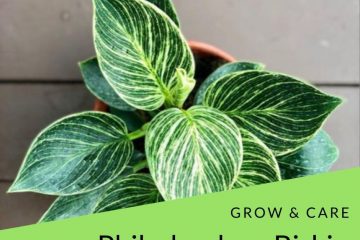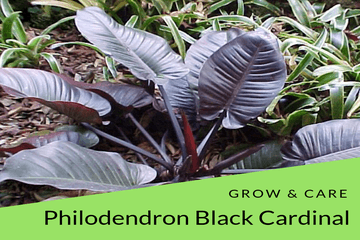How to grow and care heartleaf Philidendron?
Heartleaf Philodendron or commonly called Philodendron cordatum because of its 2-4 inch heart-shaped leaves. Heart Leaf Philodendron is an epiphytic and epilithic species of Philodendron. This Philodendron endemic to southeastern Brazil. Heart Leaf Philodendron is typically a vining plant that can tolerate shade. Despite of its toxicity (similar to other Philodendrons) ,this Philodendron is popular as a houseplant in temperate regions.
Heartleaf philodendron as indoor plant
Heartleaf philodendrons are often grown in hanging baskets which allow the thin stems and heart-shaped leaves to beautifully spill out of their container.
When heartleaf philodendron grown in a container indoor its can be displayed as a specimen plant on a table, shelf, or wall bracket, where the long, trailing vines of the plant can have room to spread. They can also be trained to climb up a screen, trellis, pole, or a bark board.
Heartleaf philodendron as outdoor plants
For those in warmer climates (USDA hardiness zones 10B through 11).did you know that this philodendron can also be grown outside for completely different results.
 Outdoor heartleaf philodendrons can be used as a groundcover. Heartleaf philodendron will quickly provide a dark green carpet in shady areas. When allowed to grow up trees or other vertical supports leaves can grow quite large, reaching 12 inches or more in length.
Outdoor heartleaf philodendrons can be used as a groundcover. Heartleaf philodendron will quickly provide a dark green carpet in shady areas. When allowed to grow up trees or other vertical supports leaves can grow quite large, reaching 12 inches or more in length.
However when Indoors, the growth of your heartleaf philodendron will be dependent on the height of their support, training, and pruning.
want to buy heartleaf philodendron?buy it at amazon for only $15.99
Heartleaf philodendron grow and care tips
| POTTING MIX Philodendrons do best in loose, well-drained soil that is high in organic matter. They will grow in 100% sphagnum peat moss. Soilless mixtures such as peat-vermiculite or peat-perlite are also satisfactory. |
| WATER When growing philodendron plants, allow the top inch of soil to dry out between waterings. The length of your index finger to the first knuckle is about an inch, so inserting your finger into the soil is a good way to check the moisture level. Droopy leaves can mean that the plant is getting too much or not enough water. But the leaves recover quickly when you correct the watering schedule. |
| SUNLIGHT Set the Philodendron in a location with bright, indirect sunlight. Find a position near a window where the sun’s rays never actually touch the foliage. While it’s normal for older leaves to yellow, if this happens to several leaves at the same time, the plant may be getting too much light. On the other hand, if the stems are long and leggy with several inches between leaves, the plant probably isn’t getting enough light |
| FERTILIZER Feed philodendron houseplants with a balanced liquid foliage houseplant fertilizer that contains macro-nutrients. Water the plant with the fertilizer monthly in spring and summer and every six to eight weeks in fall and winter. Slow growth and small leaf size is the plant’s way of telling you that it isn’t getting enough fertilizer. Pale new leaves usually indicate that the plant isn’t getting enough calcium and magnesium, which are essential micro-nutrients for philodendrons. |
| TEMPERATURE The ideal temperature for a philodendron is between 65 – 78°F during the day, and around 60°F at night. |
| TOXICITY Philodendron should not be consumed by animals or humans. Lacy tree philodendrons are toxic to cats and dogs. Being educated on poisonous plants can help you avoid any accidents all the while enjoying your greenery. |
| PEST PROBLEMS Philodendron are not prone to insects, but you may encounter aphids and mealybugs. You can wipe off mealybugs with cotton balls dipped in rubbing alcohol. Periodically showering the plant with water and applying insecticidal soap will help keep pests at bay. |
When to repot your Heartleaf philodendron?
It will thrive in a small pot for years with little care. Repot every 2-3 years, in spring or early summer. Use a container with drainage holes to prevent root rot.
If you want to use a decorative container without drainage, use it as a cachepot. Just slip your plain nursery pot into the cachepot. I like to cover the bottom of a cachepot with pebbles to keep the philodendron plant above the drainage water.
do you need more information about repotting philodendron plant? read here
How to pinch your Heartleaf philodendron?
Without pinching, this philodendron will grow with long, single stems and become lanky. You can pinch it back anytime to help it branch out hence it will make the Philodendron bushy and full. Always pinch after a leaf node (the place where a leaf is attached to the stem). A new stem will grow from that node.
apart from that you also can prune your philodendron plant.For more information about pruning your philodendron you can read here
Pinching tip: Try to pinch close to the node because any bare stem that is left will die, and the node will not grow a new stem. Make a clean cut — avoid jagged tears, which can attract disease. You can use your fingernails to pinch, or use sharp scissors or pruners
Besides that you can let it grow. Few house plants are as eager to climb as a heartleaf philodendron. If you allow the long stems to grow, put the plant in a hanging basket. Apart from that you also can let it trail from a shelf or bookcase. To train it to climb a moss pole, use floral tape to hold the stems up to the pole, until its aerial roots sink in
Despite its tropical origins, this beautiful evergreen philodendron plant is tolerant of dry air, although it appreciates occasional misting. Keep its leaves clean by wiping them with a damp cloth
do you want to buy heartleaf philodendron?click here






8 Comments
jessica · January 2, 2019 at 8:02 pm
Hello! I just purchased a heart leaf Philodendron yesterday…. When I took it home I repotted it in brand new soil and a brand new pot. I noticed that shortly after I repotted it , the leaves were droopy. Is this normal practice for this type of plant?
Jessica
philodendron · February 2, 2019 at 3:56 pm
its normal for the plant dropsy after repot. give your plant to recover for 3-4 days
Www.cleanairinitiative.org · April 7, 2019 at 1:18 am
I spent a lot of time to locate something like this
philodendron · April 7, 2019 at 2:02 am
glad you like it.hopefully this artice will help you in taking care your heartleaf philodendron
Carla · April 17, 2019 at 12:08 pm
Thanks to the great guide
Blanche · April 24, 2019 at 6:25 pm
Thanks, it is very informative
Lacy · July 13, 2019 at 8:58 am
It works really well for me
philodendron · July 13, 2019 at 12:53 pm
glad to hear it